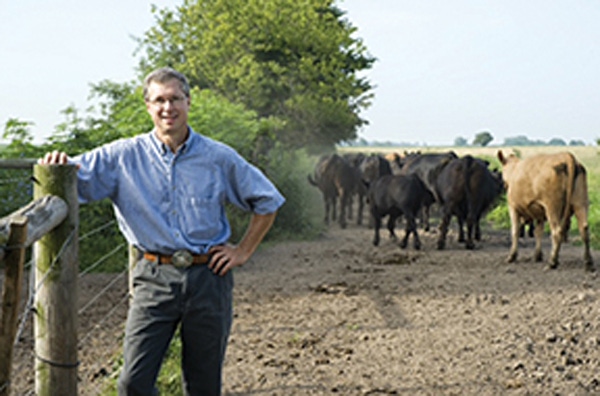Instead of the traditional fixer of broken cows, I want to be their partner in a healthy and profitable herd. Don’t you?
March 3, 2015

The next time you are driving between calls, take note of your steering wheel. Do you hold it tightly in a fixed position as you drive down a perfectly straight road, or do you constantly make minor adjustments to the wheel? The wheel is just like our veterinary practices. If we hold the wheel tightly and perfectly straight we will eventually run off the road; but if we make constant, minor adjustments, we stay on our path. No business stays on the leading edge by holding tightly and doing everything the way they’ve been done forever.
One of the best books I’ve ever read is Good to Great by Jim Collins. If you’ve read it, you may agree. If not, you need to read it. There are numerous bullet points in the book and many will apply to our profession. The title hints at the main theme. How do you take a business from Good to Great?
In the book, Collins asks the question, “What is the enemy of great?” Most would surmise it is some negative term like “bad” or “poor” as in customer service, quality of product, etc. He makes the point that actually “good” is the enemy of “great.” When companies (or people or veterinary businesses) get “good” they tend to become satisfied and never keep moving forward to become “great.” We get satisfied with “good” and becoming “great” becomes a distant memory.
Great veterinary clinics provide the services that their clients want, need and will pay to have done. Those services may include herd records, embryo transfer/in vitro fertilization, nutrition consultation, forage/pasture management information, fetal sexing, financial analysis, marketing assistance, etc. I’ll use records and nutrition as examples. Clinics that input records, produce reports and analyze herd records provide a valuable service to their clients. Cows that are “asking to leave the herd” can be identified and sold. If a clinic has numerous herds on a records program, this allows clients to compare key data like calving distribution, pregnancy rate, calf death loss, percent dystocias, etc., with data from the average of all herds on record. Benchmarking can also help producers see where improvements can be made. We also take the opposite approach and have producers that consistently beat benchmarks speak at our producer meetings so others can learn from them.
Nutritional consultation for beef herds is an area where we can make significant impact on the health and profitability of the herd. While most DVMs will not be able to walk out of school and give much advice on herd nutrition issues, there are ample opportunities for DVMs to learn more about nutrition so they can be an asset to their clients. The ideal arrangement would be to employ the services of a PhD nutritionist.
While testing hay, silage and coproduct feeds are commonplace for dairies and feedlots, it is rare in most cow-calf herds. Simply testing hay and allocating to the proper group—best hay for bred heifers, poorest for older cows—will save thousands of dollars in a 100-head cow herd according to studies in Nebraska. Going one step further and actually looking at feedstuffs on a cost and nutrient basis to make a balanced, low-cost ration, will save your clients potentially thousands of dollars. Nutrition consulting is a win-win-win proposition where the cows, client and clinic benefit.
Do you need continuing education to become great at some aspect of veterinary medicine? If so, sign up for that American Association of Bovine Practitioners preconference seminar or that wet lab at a veterinary college. It will be money well spent.
If there was an award for poorest job in marketing that a business can do for its customers, I think food animal veterinarians would be on the short list. Many of us grew up as hard-working, rural kids and bragging was not tolerated. I can recall my parents reminding us kids that we were never to boast of our activities. We were to work hard and have an inward sense of accomplishment, but others need not know. Baseball legend Dizzy Dean said, “It ain’t braggin’ if you can do it.” Maybe we need to post that quote in our private offices at our clinics. I think food animal veterinarians worry so much about talking about what we can do, that we cheat our clients. If we can help them improve their genetics, tighten their calving interval, or prevent dystocias, we need to let them know we can help. The National Animal Health Monitoring System report from 2008 shows that 53.1 percent of beef producers view their DVM as a very important source of information in their operation; tops among
all sources.
I was attending a veterinary meeting and Dr. Franklyn Garry from Colorado State University made a statement I memorized. He said, “We [veterinarians] spend too much time doing what we’re asked to do and not enough doing what needs to be done.” Open that door with your clients and “ask what needs to be done.”
We need to always ask our clients “What are your top two to three short-term and long-term goals and how can our clinic help you achieve those goals?” We ask our top clients this question every year and we record their answers, along with our recommendations in their herd report. This has made a tremendous difference in how we are viewed by those clients. We become a business partner with most of them, an asset to their herd.
Instead of the traditional fixer of broken cows, I want to be their partner in a healthy and profitable herd. Don’t you?
You might also like:
Breathtaking photos of winter on the ranch
Bale grazing lets cows feed themselves
It's possible to pasture cattle without using fences
70 photos honor the hardworking cowboys on the ranch
7 U.S. cattle operations honored for stewardship efforts
How Schiefelbein Farms made room on the ranch for nine sons
About the Author(s)
You May Also Like





